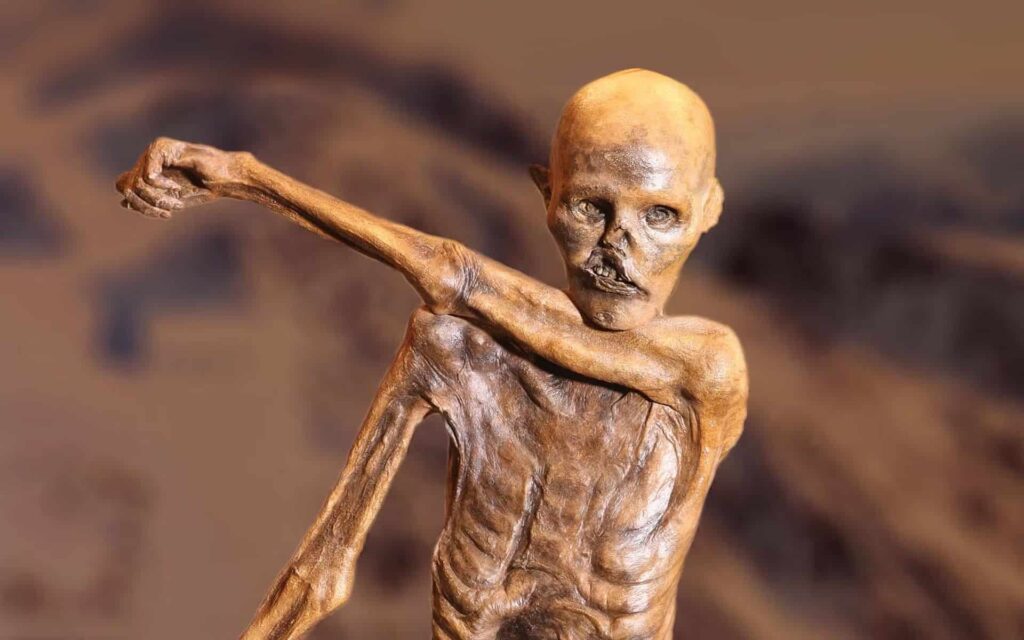A recent study has revealed new insights into the ancient DNA of 47 individuals from the Eastern Italian Alps, including Ötzi the Iceman. The research sheds light on the genetic makeup and social dynamics of prehistoric Alpine populations, offering a deeper understanding of their ancestry.
Published in Nature Communications, the study analyzes genomes from individuals who lived between 6400 and 1300 BCE, spanning from the Mesolithic to the end of the Middle Bronze Age. As reported by ArchaeologyMag, this research provides valuable data, although it still leaves many questions about Ötzi’s origins and genetic legacy unanswered.
Ötzi the Iceman’s unexpected genetic origins
For decades, the 5,300-year-old mummified Ötzi has puzzled scientists with his unique genetic profile. While he shares many traits with nearby Copper Age people, his distinct Y-chromosome haplogroup (G2a-Z6208) and mitochondrial DNA set him apart as a genetic anomaly. This latest study not only confirms his genetic differences but also deepens the mystery of his origins.
His genome is rich in Anatolian farmer ancestry, but his Y-chromosome haplogroup (G2a-Z6208) and mitochondrial DNA are unlike those of any other ancient or modern individuals, making him a true genetic outlier.
Patrilocal society: How Alpine social structure shaped genetic lineages
The research team led by Valentina Coia found that the Alpine populations exhibited a unique social structure. Men tended to stay within their communities, while women moved to male-dominated areas. This resulted in the stabilization of male genetic lines, while maternal lines showed a broader range of external connections.

The study revealed low Y-chromosome marker diversity but high mitochondrial DNA diversity in Alpine men, which suggests a patrilocal society. This social structure helped shape the genetic makeup of the region over thousands of years.
Dark hair, brown eyes, and a dairy-free diet
One of the most striking findings of the study was the prediction of physical traits based on the ancient DNA. Much like Ötzi the Iceman, the majority of individuals analyzed were found to have dark hair and brown eyes, a physical appearance that seems to have been common among the Alpine populations at the time.
Additionally, similar to Ötzi, many of these individuals were lactose intolerant, with none carrying the genetic markers necessary for digesting milk. This suggests that milk had not yet become a staple in the diet of these prehistoric communities, providing important insight into the early dietary habits of the region.
Occasional foreign influence: The surprising genetic encounters
Though the DNA revealed strong continuity in the region, the researchers also discovered rare traces of foreign ancestry. For instance, a small girl from 2400 BCE (LAS01) had Steppe-affiliated ancestry, indicating limited contact with Bronze Age groups arriving from the steppes.


Another individual, SIU01, dating to 1600 BCE, had both Steppe genes and the haplogroup R1b*, typically found in the Bell Beaker culture. Other individuals like NOG302 and ROM402 exhibited gene flow from the Eastern Mediterranean and the Caucasus, pointing to occasional but significant exchanges with distant regions.
Despite these occasional genetic influxes, the region maintained a remarkable degree of stability. The study concluded that the Eastern Italian Alps were more of a genetic stronghold than a crossroads, remaining resistant to major demographic shifts while remaining open to limited cultural and genetic exchanges.

